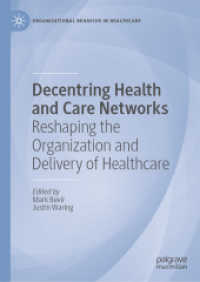Full Description
Long-term prescription opioid use occurs in a substantial proportion of new opioid users. Most concerning is that high risk patients with comorbid depression, anxiety, nicotine dependence, and substance use disorders, compared to patients without these factors, continue to be prescribed higher opioid doses for longer durations, and are more likely to receive opioids with high abuse potential. To understand this phenomenon, we must consider the relationships between pain, mental illness, substance use disorder and long-term prescription opioid use. While separate fields have investigated the bi-directional relationships between depression, pain, and long-term prescription opioid use independently of one another, there is no text which has brought together the complex interaction of all three together.
Drawing on contributions from neuroscience, pain psychiatry, clinical epidemiology, pharmacoepidemiology, clinical trials and research on social determinants of health, Pain, the Opioid Epidemic, and Depression is the first book to integrate currently siloed areas of investigation and clinical knowledge. This book takes a comprehensive approach, from neurophysiology to epidemiology to clinical practice, and explains the processes driving maintenance of chronic pain, persistent depression, and long-term prescription opioid use, as well as taper and buprenorphine treatment for opioid use disorder. Readers will come to understand the central role of depression, other psychiatric disorders, and social determinants that contribute to pain management outcomes, the opioid epidemic, and our response to opioid dependence and opioid use disorder. By taking a multidisciplinary approach to compiling what is known about the relationships between pain, depression, other psychiatric disorders and opioids, this volume will be a valuable clinical resource for a range of healthcare and mental health professionals who encounter chronic pain and comorbid mood disorders, while also spawning new directions for researchers.
Contents
Chapter 1: Jeffrey F. Scherrer and Jane C. Ballantyne: Overview and Purpose
Chapter 2: Geoffrey Panjeton and Hess Amir Panjeton: Neurophysiology of Pain, Depression, and Exogenous Opioids
Chapter 3: Mark D. Sullivan: Looking Beyond Tissue Damage: Pain as a Homeostatic Emotion
Chapter 4: Jeffrey F. Scherrer and Joanne Salas: Prescription Opioid Use and Risk of Depression and Worsening Mental Health
Chapter 5: Lisa R. Miller-Matero: Depression and Pain: Bidirectional Relationship and Changes with Psychological Treatment
Chapter 6: Matthew J. Bair and Ashli A. Owen-Smith: Other Psychiatric Disorders, Psychosocial Factors, Sleep, and Pain
Chapter 7: Fred Rottnek and Jennifer Bello-Kottenstette: The Impact of Social and Structural Determinants on Depression, Prescription Opioid Use, Opioid Misuse, and Opioid Use Disorder
Chapter 8: Travis I. Lovejoy and Belle Zaccari: Opioid Taper and Complex Prescription Opioid Dependence: The Role of Depression
Chapter 9: Ajay Manhapra, Robert Rosenheck and William C. Becker: Potential Role for Buprenorphine in the Management of Comorbid Depression Among People with Chronic Pain and Long-Term Opioid Therapy Dependence
Chapter 10: Jane C. Ballantyne, Mark D. Sullivan and Jeffrey F. Scherrer: Future Directions in Pain Management: Implications for Depression and Mental Health








